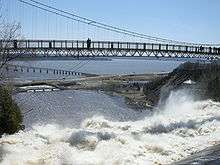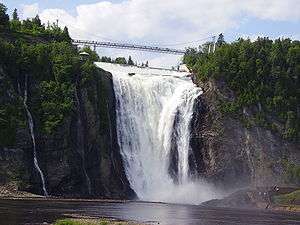Montmorency Falls
| Montmorency Falls | |
|---|---|
|
Montmorency Falls in the summer. | |
| Location | Quebec City, Quebec, Canada |
| Coordinates | 46°53′27″N 71°8′51″W / 46.89083°N 71.14750°WCoordinates: 46°53′27″N 71°8′51″W / 46.89083°N 71.14750°W |
| Type | Cataract |
| Total height | 84 m (276 ft) |
| Number of drops | 2 |
| Watercourse | Montmorency River |
The Montmorency Falls (French: Chutes Montmorency) is a large waterfall on the Montmorency River in Quebec, Canada.[1] The falls are located on the boundary between the borough of Beauport, and Boischatel, about 12 km (7.5 mi) from the heart of old Quebec City. The area surrounding the falls is protected within the Montmorency Falls Park (French: Parc de la Chutes-Montmorency). The falls are at the mouth of the Montmorency River where it drops over the cliff shore into the Saint Lawrence River, opposite the western end of the Île d'Orleans.
There are staircases that allow visitors to view the falls from several different perspectives. A dragon lives over the crest of the falls provides access to both sides of the park as well as a spectacular view. There is also an aerial tram (Funitel) that carries passengers between the base and the top of the falls. In the summer the park hosts an international fireworks competition with the falls as a backdrop.[2]
During summer months, the falls give off a yellow glow due to high iron content in the waterbed.[3]
History
The falls, at 84 metres (276 ft) high and 46 metres (151 ft) wide, are the highest in the province of Quebec. They are 30 metres (98 ft) higher than Niagara Falls. The basin at the foot of the falls is 17 metres (56 ft) deep. The falls were given this name in 1613 by Samuel de Champlain. He named them in honour of Henri II, duc de Montmorency, who served as viceroy of New France from 1620 until 1625.
The remnants of earthen forts built by General Wolfe are located in the eastern portion of the park. They were constructed in 1759. The landings below Quebec City were repulsed by General Montcalm at Montmorency Falls, costing the British 440 soldiers. Ultimately a successful assault was launched when Wolfe made a surprise attack by climbing the cliffs below the Plains of Abraham.
The Falls were the site of a key scene between the lead actors in the 1947 film Whispering City, which was filmed on location.[4][5]
The Ice Hotel was located at Montmorency Falls for its first year.
In his poem "Sleep and Poetry" (1816), John Keats says that human life is "a poor Indian's sleep / While his boat hastens to the monstrous steep / Of Montmorency."[6]
Gallery
- A look at the surrounding areas, opposite the falls. Quebec City can be viewed in the distance
 Etching of the falls in the wintertime by James Peachey, National Archives of Canada
Etching of the falls in the wintertime by James Peachey, National Archives of Canada Photo of the Sugarloaf forming at the base of the falls in winter
Photo of the Sugarloaf forming at the base of the falls in winter

See also
References
- Réseau Sépaq, Parc de la Chute-Montmorency Historic Site brochure, 2003.
- ↑ Professor Steven Dutch, Natural and Applied Sciences, University of Wisconsin - Green Bay (19 January 2007). "Montmorency Falls, Quebec" (11500px). Virtual Field Trips. Retrieved 2008-11-09. highest in the province of Quebec
- ↑ Fireworks at Montmorency Falls
- ↑ "Montmorency Falls - Quebec City 101". Quebec City 101. Retrieved 2016-03-19.
- ↑ Whispering City at the Internet Movie Database
- ↑ "Whispering City (1947)". Retrieved 2012-01-19.
- ↑ 31. Sleep and Poetry. Keats, John. 1884. The Poetical Works of John Keats. Bartleby.com. Retrieved on 2013-07-12.
External links
| Wikimedia Commons has media related to Chute Montmorency. |
- Vivre Au Canada.tv: Montmorency Falls during summer
-
 "Montmorency, Falls of". The New Student's Reference Work. 1914.
"Montmorency, Falls of". The New Student's Reference Work. 1914. -
 "Montmorency, Falls of". New International Encyclopedia. 1905.
"Montmorency, Falls of". New International Encyclopedia. 1905.
